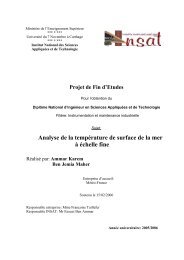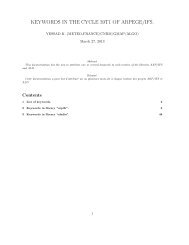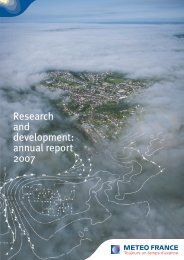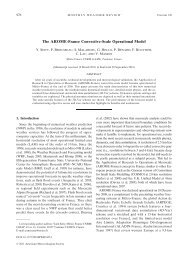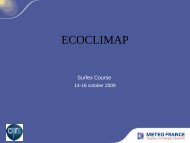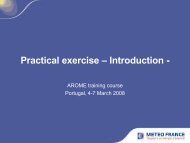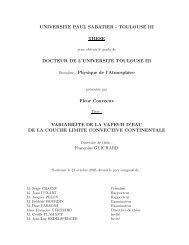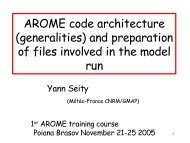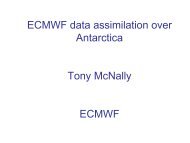Downslope windstorm in High Tatras, 19 November 2004
Downslope windstorm in High Tatras, 19 November 2004
Downslope windstorm in High Tatras, 19 November 2004
- No tags were found...
You also want an ePaper? Increase the reach of your titles
YUMPU automatically turns print PDFs into web optimized ePapers that Google loves.
<strong>Downslope</strong> <strong>w<strong>in</strong>dstorm</strong> <strong>in</strong> <strong>High</strong> <strong>Tatras</strong><strong>19</strong> <strong>November</strong> <strong>2004</strong>high resolution studybyAndré Simon, Jozef VivodaSHMÚ
Photo: J.P<strong>in</strong>terováImpact of the <strong>19</strong> <strong>November</strong> <strong>w<strong>in</strong>dstorm</strong>• Southern part of <strong>High</strong>- and Low <strong>Tatras</strong>: 120 km 2 offorest destroyed (ma<strong>in</strong> turistic centre of Slovakia)• Measured w<strong>in</strong>d gusts: 30 – 60 m/s• Period: 14 – <strong>19</strong> UTC• Biggest impact: zone of forest, between 750 – 1200 mabove sea level• Very rare event <strong>in</strong> such low altitudes(previous storms: <strong>19</strong>15, <strong>19</strong><strong>19</strong>,<strong>19</strong>41)
Impact of the <strong>19</strong> <strong>November</strong> <strong>w<strong>in</strong>dstorm</strong>• Belt of destroyed forest on the southern (lee) sideof the <strong>High</strong> <strong>Tatras</strong>Source: SOPSR, TANAP
Synoptic analysisSatellite <strong>in</strong>frared channel, MSLP (hPa) and fronts
Local observations• Gusty character of w<strong>in</strong>d, hourly average w<strong>in</strong>dspeeds almost 20 m/s, gusts over 50 m/s09 12 15 18 CETW<strong>in</strong>d directionRemarkable pressureoscillations: high turbulenceAverage w<strong>in</strong>d speed40 m/sW<strong>in</strong>d gusts20 m/s00900 hPa12 00 CETStation Stará Lesná, Slovak Academy of SciencesAnemogram+barogram890 hPa
Microscale features• Aerial photographs: evidence of strong downslope w<strong>in</strong>ds(orientation of fallen trees)Biggest damage:foots of the slopes,exits of valleysadapted fromaerial photograph strong vertical w<strong>in</strong>d shears <strong>in</strong> th<strong>in</strong> layer⇒ generation of extremely high horizontal vorticity analogical to flow <strong>in</strong> travell<strong>in</strong>g microbursts
Success of the operational forecast• ALADIN SLOVAKIA, cycle 25, 9.0 km resolution2.5km resolution runW<strong>in</strong>d speed (km/h)Operational runObservationObservationTime (UTC)Time course of observed and forecasted w<strong>in</strong>d gusts, station „Lomnický Štít“Based: <strong>19</strong>/11/<strong>2004</strong> 00 UTC run
Why to do high resolution modell<strong>in</strong>g?• Improved spatial distribution of w<strong>in</strong>d gusts and betterlocalization of the w<strong>in</strong>d speed maxima• More <strong>in</strong>formation about the nature of the event –important for the forecasters• Tool: 2.5 km hydrostatic ALADIN model with physics2.5 km dynamic adaptation of ALADIN SLOVAKIA2.5 km non-hydrostatic model(ALADIN NH dynamics+physics, cycle 29)• We concentrated on short range forecasts of w<strong>in</strong>d andpressure distribution (00h – 24 h range)
2.5 km hydrostatic run with physics• Areas of predicted max. gusts co<strong>in</strong>cide with the damageobservations, better performance for low Tatra region• Big pressure gradient and strong crossisobaric w<strong>in</strong>d(lee cyclone due to block<strong>in</strong>g of air)15 h forecast of w<strong>in</strong>d gusts 15 h forecast of 10m w<strong>in</strong>d and MSLP
2.5 km hydrostatic run with physics• Extreme w<strong>in</strong>d speeds on the lee side: area of <strong>in</strong>creasedstatic stability and downslop<strong>in</strong>g isotherms of „θ“• Vertical velocities: effect similar to “hydraulic jump”NWPotential vorticity + w<strong>in</strong>dSEPot. Temperature + Vertical velocity (Pa/s)
2,5 km non- hydrostatic run• Time shift of the event (max. w<strong>in</strong>d speeds 3 h later)• ma<strong>in</strong> structure of the flow similar to hydrostatic runPotential vorticity + w<strong>in</strong>dTrue vertical velocities (m/s)
Comparison of all runsMax.40 m/sMax.51 m/sOperational 9.0 km runHydrostatic 2.5 km runMax.58 m/s18 UTCMax.35 Max.50 m/s2.5 km dynamic adaptation2.5 km non-hydrostatic run15 h forecast of w<strong>in</strong>d gusts: direction + speed (m/s)
Sensitivity testsMax. gust 40 m/s33 m/sOperational cy25Cy28 t3, FACRAF=10CZPHYS42 m/s 26 m/sCy28t3, FACRAF=15Cy 28t3 – without envelope+SLHD10 m w<strong>in</strong>d, w<strong>in</strong>d gusts (shades), MSLP (hPa)
Mesoscale diagnostics• Theory of downslope <strong>w<strong>in</strong>dstorm</strong>s:• Supercritical flow: Froud number 1• Several analytical models an criterions …• Mostly:Less stable airFr =UN HShallow water hydraulic model:adapted from Holton (<strong>19</strong>92)Stable airSupercritical flowFr 1turbulent adjustmentto subcritical environment
Mesoscale diagnostics• Increase of stability withheight• Below 3000 m Froudnumber > 1 (air can flowover mounta<strong>in</strong>s)Froud numberBV x 100RiFr=1w<strong>in</strong>d shear and “θ”Fr=1Froud number0 0,02 0,04 0,06 s -1 K
Mesoscale diagnostics• Increase of stability on the lee side – <strong>in</strong>dicatesa strong downslope w<strong>in</strong>dApproximate Froud numberMean Brunt Vaisala frequency
Conclusions: po<strong>in</strong>ts of view• NWP Operation: <strong>High</strong> resolution models, evenhydrostatic, enable to forecast such unusual severeevent, dynamic adaptation seems to be sufficient• Forecast<strong>in</strong>g: All HR runs forecast the ma<strong>in</strong>characteristics of downslope <strong>w<strong>in</strong>dstorm</strong>s (e.g. hydraulicjump)• NWP Development: A case study necessary to test <strong>in</strong>new cycles, probably high dependence on physicalparameterisation (turbulence scheme ?)• Science: needs for better analytical model + higherresolution model to simulate microscale effects
Acknowledgements• to Mária Derková for supervision of thesensitivity experiments• to all colleagues who helped us and contributedto this study



